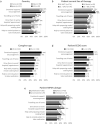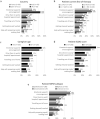Caregivers of patients with malignant pleural mesothelioma: who provides care, what care do they provide and what burden do they experience?
- PMID: 37097405
- PMCID: PMC10393857
- DOI: 10.1007/s11136-023-03410-4
Caregivers of patients with malignant pleural mesothelioma: who provides care, what care do they provide and what burden do they experience?
Abstract
Purpose: There are limited data on the impact of caregiving for patients with malignant pleural mesothelioma (MPM) on the caregiver. We aimed to identify the demographic characteristics of these caregivers, the caregiving activities they perform and how caregiving burden impacts their work productivity and overall activity.
Methods: This cross-sectional study collected data from caregivers of patients with MPM across France, Italy, Spain and the United Kingdom January-June 2019. Caregiver demographics, daily caregiving tasks and the impact of caregiving on physical health was collected via questionnaire. The Zarit Burden Interview (ZBI) was used to assess caregiver burden and the Work Productivity and Activity Impairment questionnaire (WPAI) assessed impairment at work and during daily activities. Analyses were descriptive.
Results: Overall, 291 caregivers provided data. Caregivers were mostly female (83%), living with the patient (82%) and their partner/spouse (71%). Caregivers provided over five hours of daily emotional/physical support to patients. ZBI scores indicated 74% of caregivers were at risk of developing depression. Employed caregivers had missed 12% of work in the past seven days, with considerable presenteeism (25%) and overall work impairment (33%) observed. Overall, the mean activity impairment was 40%.
Conclusion: Caregivers provide essential care for those with MPM. We show caregiving for patients with MPM involves a range of burdensome tasks that impact caregivers' emotional health and work reflected in ZBI and WPAI scores. Innovations in the management of MPM must account for how caregivers may be impacted and can be supported to carry out this important role.
Keywords: Caregiver burden; Malignant; Mesothelioma; Patient care; Quality of life.
© 2023. The Author(s).
Conflict of interest statement
MD and BB are employees of Bristol Myers Squibb. GT and AM are employees of Adelphi Real World and were paid consultants to Bristol Myers Squibb in connection with the development of this manuscript.
Figures





Similar articles
-
Development of Patient and Caregiver Conceptual Models Investigating the Health-Related Quality of Life Impacts of Malignant Pleural Mesothelioma.Patient. 2024 Sep;17(5):551-563. doi: 10.1007/s40271-024-00690-x. Epub 2024 Apr 15. Patient. 2024. PMID: 38619810
-
The humanistic burden of advanced non-small cell lung cancer (NSCLC) in Europe: a real-world survey linking patient clinical factors to patient and caregiver burden.Qual Life Res. 2019 Jul;28(7):1849-1861. doi: 10.1007/s11136-019-02152-6. Epub 2019 Mar 2. Qual Life Res. 2019. PMID: 30825160 Free PMC article.
-
The humanistic burden associated with caring for patients with advanced non-small cell lung cancer (NSCLC) in three European countries-a real-world survey of caregivers.Support Care Cancer. 2019 May;27(5):1709-1719. doi: 10.1007/s00520-018-4419-3. Epub 2018 Aug 18. Support Care Cancer. 2019. PMID: 30121787
-
Health-related quality of life and productivity burden for non-professional caregivers of adults with rare diseases: a real-world study.Orphanet J Rare Dis. 2025 Jun 6;20(1):282. doi: 10.1186/s13023-025-03796-z. Orphanet J Rare Dis. 2025. PMID: 40481583 Free PMC article.
-
[Caregiver burden in relatives of persons with schizophrenia: an overview of measure instruments].Encephale. 2003 Mar-Apr;29(2):137-47. Encephale. 2003. PMID: 14567165 Review. French.
Cited by
-
Treatment patterns and humanistic burden of malignant pleural mesothelioma in Spain.Clin Transl Oncol. 2025 Jan;27(1):213-222. doi: 10.1007/s12094-024-03591-5. Epub 2024 Jul 6. Clin Transl Oncol. 2025. PMID: 38970770 Free PMC article.
-
Living with mesothelioma: a systematic review of mental health and well-being impacts and interventions for patients and their informal carers.BMJ Open. 2024 Jul 1;14(6):e075071. doi: 10.1136/bmjopen-2023-075071. BMJ Open. 2024. PMID: 38951010 Free PMC article.
-
Pleural mesothelioma.Nat Rev Dis Primers. 2025 Aug 7;11(1):56. doi: 10.1038/s41572-025-00640-3. Nat Rev Dis Primers. 2025. PMID: 40775245 Review.
-
Palliative and end-of-life care for patients with pleural mesothelioma: A cohort study.Palliat Med. 2025 Feb;39(2):286-297. doi: 10.1177/02692163241302454. Epub 2024 Dec 17. Palliat Med. 2025. PMID: 39686762 Free PMC article.
References
-
- Corfiati M, Scarselli A, Binazzi A, Di Marzio D, Verardo M, Mirabelli D, Gennaro V, Mensi C, Schallemberg G, Merler E, Negro C, Romanelli A, Chellini E, Silvestri S, Cocchioni M, Pascucci C, Stracci F, Romeo E, Trafficante L, Angelillo I, Menegozzo S, Musti M, Cavone D, Cauzillo G, Tallarigo F, Tumino R, Melis M, Iavicoli S, Marinaccio A, ReNa MWG. Epidemiological patterns of asbestos exposure and spatial clusters of incident cases of malignant mesothelioma from the Italian national registry. BMC Cancer. 2015;15:286. - PMC - PubMed
-
- Reid A, de Klerk NH, Magnani C, Ferrante D, Berry G, Musk AW, Merler E. Mesothelioma risk after 40 years since first exposure to asbestos: A pooled analysis. Thorax. 2014;69(9):843–850. - PubMed
-
- Wilk E, Krowczynska M. Malignant mesothelioma and asbestos exposure in Europe: Evidence of spatial clustering. Geospat Health. 2021;16(1):91–102. - PubMed
-
- Beckett P, Edwards J, Fennell D, Hubbard R, Woolhouse I, Peake MD. Demographics, management and survival of patients with malignant pleural mesothelioma in the national lung cancer audit in England and Wales. Lung Cancer. 2015;88(3):344–348. - PubMed
MeSH terms
LinkOut - more resources
Full Text Sources
Medical
Miscellaneous

